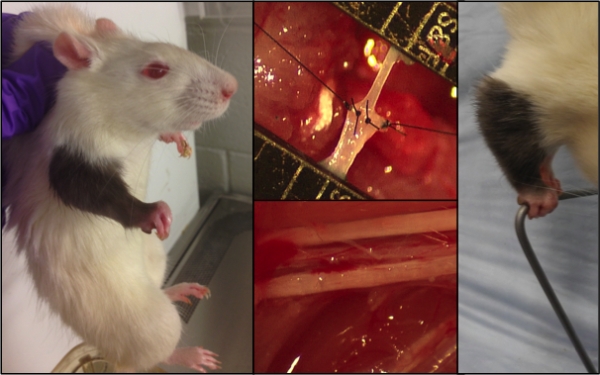Rat Forelimb Allotransplantation: A Novel Microsurgical Model for Optimized Functional Assessment After Reconstructive Transplantation
1Plastic & Reconstructive Surgery, Johns Hopkins University, Baltimore, MD
2Neurology and NeuroSurgery, Johns Hopkins University, Baltimore, MD.
Meeting: 2015 American Transplant Congress
Abstract number: 348
Keywords: Graft function, Nerve allografts, Rat, Tissue-specific
Session Information
Session Name: Concurrent Session: Composite Tissue Allografts: Basic and Translational
Session Type: Concurrent Session
Date: Tuesday, May 5, 2015
Session Time: 2:15pm-3:45pm
 Presentation Time: 3:27pm-3:39pm
Presentation Time: 3:27pm-3:39pm
Location: Room 119-A
Background:
Functional outcomes following vascularized composite allotransplantation (VCA) have been promising, but there is still room for improvement. Studies to investigate strategies to overcome this obstacle are limited by the lack of a functional VCA animal model. To address this problem, we developed a novel forelimb transplant model in which functional recovery is tested by measuring progressive return of grip-strength within the transplanted forelimb.
Methods:
Orthotopic forelimb allotransplantation (Brown Norway to Lewis) is performed at mid-humerus level, with end-to-end suture anastomosis of brachial artery and vein. Median and radial nerves are approximated in the experimental group to innervate extrinsic flexor and extensor muscles, respectively, and left in discontinuity in the control group (N=8 per group). Weekly grip strength testing is performed with a force transducer device. At 12 weeks, all animals are sacrificed for median nerve histomorphometry and flexor digitorum neuromuscular junction analysis.
Results:
After an initial learning curve, forelimb transplantation can be performed with consistent success (operative time 180-220 minutes). Long-term graft survival (120 days) was achieved with immunosuppressive treatment. Allograft rejection without treatment occurred within 10 days. Animals reflexively use the transplanted forelimb to grasp a bar, with progressive improvement in grip strength observed beginning at 3 weeks. Statistical analysis of grip strength data, nerve histomorphometry and neuromuscular junction analysis are pending completion of study.
Conclusion:
Rat forelimb transplantation may represent the first VCA model that allows for reliable and reproducible measurement of functional recovery. Statistical analysis of grip strength data will elucidate the degree of variability at each time-point and the degree of improvement from week to week as compared to non-innervated controls.

To cite this abstract in AMA style:
Kern B, Tuffaha S, Khusheim M, Xiang S, Furtmueller G, Sarhane K, Park J, Hoke A, Lee W, Brandacher G. Rat Forelimb Allotransplantation: A Novel Microsurgical Model for Optimized Functional Assessment After Reconstructive Transplantation [abstract]. Am J Transplant. 2015; 15 (suppl 3). https://atcmeetingabstracts.com/abstract/rat-forelimb-allotransplantation-a-novel-microsurgical-model-for-optimized-functional-assessment-after-reconstructive-transplantation/. Accessed July 18, 2025.« Back to 2015 American Transplant Congress
